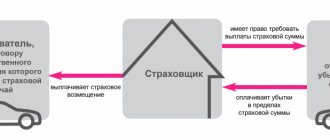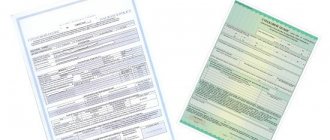Publication date: 03/04/2019 Number of views: 5856
Author: Ermakov Andrey Valerievich Lawyer, partner of the Legal Agency of St. Petersburg Articles written: 20
The situation when an insurance company files a lawsuit against the culprit of an accident in order to recover material damage based on the compensation paid to the injured party is becoming more and more common every year. If previously relatively little-known organizations that had close ties with collection agencies committed similar sins, today you can get a claim for subrogation or recourse from almost any insurance company. Recently, there has been increased activity on the part of the insurance company, which is trying to compensate for its losses under CASCO or OSAGO contracts by filing lawsuits against those responsible for the accident. There is a trend: if the accident occurred in 2015 or 2021 (the statute of limitations is about to expire), and the amount of paid material damage exceeds 100-120 thousand rubles, you can expect a quick summons from the court. There are many explanations for this: the unstable economic situation in the country, a sharply increased number of vehicles, competition in the market, tightening legislation in the field of insurance companies. In order to somehow preserve their assets and not become bankrupt, they are forced to resort to subrogation and recourse claims. What to do if the insurance company sues the person responsible for the accident, what is the difference between recourse and subrogation, is it possible to reduce the amount of payments for a lawsuit and how to protect your property rights? Answers to these and related questions are provided by professional lawyers in the field of insurance law and civil law.
What is subrogation under CASCO?
Subrogation under CASCO is usually understood as circumstances that allow the insurance company to demand a certain amount of compensation from the culprit of the accident.
There are 2 options for subrogation:
- If the amount of compensation is less than 400,000 rubles, the claim will be sent to the liability insurance company of the person responsible for the accident.
- If the amount of compensation exceeds 400,000 rubles, the claim goes to the culprit himself.
How does comprehensive insurance recover money from the person responsible for the accident? This is done as follows:
- The owner of the CASCO policy will not charge the person at fault for the accident. The injured party will receive the necessary payments from the insurance company with which it has a contract.
- Once a client's injury is covered, the insurance company has the right to subrogation. This allows the insurer to recover money from the person who caused the accident.
- If the at-fault driver has a third party insurance policy, the at-fault driver's insurance company will pay out.
The longer a car's lifespan, the cheaper it is. This means that at the time of the accident the car will be worth less than when you bought it. However, this does not change the fact that only new parts will be used to restore the car.
The insurer has the right to subrogation only if the damaged vehicle has a CASCO policy. In case of liability to third parties, the insurance company is obliged to cover all repair costs at its own expense.
However, these are not all the conditions that must be met for subrogation:
- The insurer paid the client the necessary amount to restore the car and fulfilled all other obligations under the contract between the parties.
- The person at fault does not have liability insurance or the amount of damage exceeds the maximum allowable payment.
The court will consider a subrogation case only if no more than three years have passed from the occurrence of the insured event to the filing of the claim. If this period was violated by the insurer, the claim against the person responsible for the accident will be invalid.
The limitation period is established by law. This term is usually understood as the period of time during which a citizen can file a claim in court.
The Civil Code of the Russian Federation spells out all the issues related to subrogation. If we turn to Article 965 of the Civil Code of the Russian Federation, then subrogation can only be applied if there is a property insurance agreement.
If there are no grounds for subrogation or the implementation of this procedure contradicts the norms of Russian legislation, such a mechanism cannot be used. Otherwise, the contract will be officially declared invalid. The car owner will only have to defend his interests in court by filing a lawsuit.
If we turn to practice, most drivers try to overestimate the amount of damage caused to their car as a result of an accident. Thus, they deceive not only their insurance company, but also the person responsible for the accident.
It is possible to avoid subrogation, but the following recommendations must be followed:
- It is prohibited to violate traffic rules while driving.
- The contract with the insurer is concluded for the maximum possible amount.
- If you receive a subrogation claim, it is better not to hesitate. It is necessary to contact a specialist and get advice.
- If you are at fault in a car accident, you should not avoid the investigation process. This is especially true when it comes to assessing property damage.
First of all, it’s worth saying right away that without the help of a professional it will be extremely difficult to solve the problem on your own. This is due to the fact that a person who is not knowledgeable in such matters will not be able to fully understand the claim received, as well as determine how legitimate the claims of the insurance company are.
To protect yourself from subrogation in advance, you must take out third party insurance. This will allow you to pay compensation not to the person who caused the accident, but to his insurer.
The MTPL policy is not cheap, but its owner does not need to worry about having to pay the full subrogation.
There is a case when the claim for subrogation on the part of the insurer cannot be considered justified. The initiator of the accident must insist in court on an investigation to prove the guilt of the other participant in the accident. If this fact is confirmed, then you will not have to pay.
First, it is important to understand what exactly the term “subrogation” means.
Here's an example. A driver with a CASCO policy gets into an accident. The traffic police found him not guilty of the accident. He received a full payment from the insurer under CASCO in the amount of 638,000 rubles.
The insurance company then sought subrogation from the at-fault company because it had a right of claim, and received compensation in the amount of RUB 400,000, the maximum possible amount. They wanted to recover the remaining 238,000 rubles from the culprit of the accident.
What to do if you have filed a claim for subrogation
If you have received a claim from an insurance company for reimbursement of expenses through subrogation, then you should not panic and frantically think about how to avoid subrogation from the insurance company. The fact is that if the insurers’ claim has a serious justification and is permitted at the legislative level, then in this case you will not have any opportunity to evade your obligations. But until this is fully proven, it is worth adhering to two rules that will help you protect yourself if subrogation is unlawful.
- Do not try to ignore the complaint under any circumstances. Otherwise, in the eyes of the court, you will automatically be found guilty and subrogation will be confirmed.
- You cannot immediately accept all claims of insurers, since it is likely that the circumstances of the accident on the road do not allow the insurance company to bill you.
As a rule, the insurance company sends a document in your name stating that, based on the fact that you are found guilty of the accident, you are obliged to reimburse the insurance amounts that were used to cover the material damage to the injured party.
And the first thing you should do after receiving this paper is to begin an intensive collection of all documentation that directly or indirectly relates to the emergency situation. Moreover, this must be done at a fast pace. Already at the stage of pre-trial settlement, you should have full documentary support on hand. This will allow you to prepare in more detail for the upcoming process, and will give you the opportunity to understand how to avoid subrogation under CASCO.
The list of recommended documentation that you must prepare must include the following papers:
- documents that confirm your guilt in the current emergency situation. This is a court decision, which has already entered into legal force, a certificate from traffic police officers, issued at the scene of the accident;
- documents that can confirm the right of the insurance company to demand the return of money from you through subrogation. In particular, all documents that in one way or another shed light on the relationship between the insurer and its client must be presented here;
- documents that directly confirm the amount of property damage that your actions caused as a result of the accident. This is an assessment by independent experts, photographs from the scene of the accident, calculation of repair work performed at the service station, etc.
Once you have collected all the necessary documents, they must be carefully and carefully studied. It is difficult to do this on your own, since an unprepared person may lose sight of important points. Therefore, at this stage, you need to contact a qualified lawyer who will help you sort out the situation and determine whether the insurance company is entitled to compensation, or whether you can create all the conditions to find out how to avoid subrogation.
However, if you decide to fully use your knowledge exclusively, then you need to pay special attention to the following points.
- Are the repairs completed adequate to cover all the damage that was sustained as a result of the accident?
- Were you present during the peer review process, or were you not involved in the process?
- Were unnecessary repairs used that could have been avoided or would not have addressed the damage caused by the accident?
If, as a result of the analysis, you have a feeling that the amount of damage does not correspond to reality (and this happens very often, since insurers do not shy away from deliberately deceiving their clients), then you can send a response claim, in which you will need to indicate the real the cost of damage, and confirmation of your readiness to repay debts.
If the insurers refuse, then the matter will be resolved in court. As practice shows, with sufficient argumentation, the court will always take your side. Especially if it becomes known that you tried to solve the problem at the pre-trial settlement stage.
The period for the company to collect insurance compensation by way of recourse. Read about the statement of claim against traffic police officers here.
Find out about vehicle inspection by road service officers at the following link:
As judicial practice shows, situations are increasingly occurring in which car enthusiasts try to make the maximum profit. The victim accepts compensation from both the insurance company and the person responsible for the accident. As a result, complications then begin, and it can be difficult to prove anything. That is why, if it so happens that an accident occurred due to your fault, and you offer the victim a peaceful settlement and are ready to reimburse his expenses, then do not forget to take a written receipt from him for receipt of funds.
Well, and most importantly, before you understand what subrogation is and how to avoid this process, you must remember that the statute of limitations on this issue is three years.
Important! We strongly recommend that you do not throw away or lose important documentation. It is likely that you may still need it.
It is also worth adding that if you are still thinking about how to avoid subrogation for an accident, then you should follow the following recommendations:
- carefully follow the rules on the road and never break them;
- conclude an insurance contract for as large a sum of money as possible. If the amount of insurance compensation is about 1 million rubles, then with this amount the insurers will not only pay off the victim’s expenses, but also their own;
- if you have received a claim for compensation under subrogation, then do not delay, and be sure to consult with specialists;
- do not distance yourself from investigative procedures. In particular, be sure to attend the examination of the damaged vehicle.
Subrogation is not such a scary procedure as it might seem at first glance. Most importantly, do not forget that the insurer can only demand from you the amount that it paid, taking into account wear and tear. Subrogation also occurs exclusively in the field of property insurance contracts. It is not easy to fully protect yourself from subrogation, but with the right situation and a balanced approach to finding a solution, you can resolve the dispute in your favor.
When does subrogation arise?
Vehicle owners only learn what subrogation is when they cause an accident. After all, CASCO, and not liability to third parties, is insurance of a car as property.
If the culprit has a compulsory motor liability insurance policy within the limits of the law, it will cover part of the costs. However, do not forget that payments for a mandatory product are strictly limited. It is no secret that there are many expensive cars on the roads, and the amount of damage may exceed the limit of payments under the liability insurance contract.
Little secrets to help you win an argument
Let's start revealing the secrets by telling you what tricks and manipulations insurers use to achieve success. Here, for example, is one of their favorite ways.
This means that they take the case to court when the statute of limitations on subrogation has already expired. They do this on the basis that it was a long time ago; the documents of the person responsible for the accident may not have been preserved, since almost three years have passed.
In addition, people do not like to go to court and most likely will not do so. And this is a mistake. Even if the statute of limitations has expired, you only need to go to court, at least to find out that the period has expired.
There are other options. By contacting a law firm, you can learn a lot of new things. Call us!
And finally, some advice for the future. Protect yourself and sign a voluntary motor insurance contract. Thanks to this, you will avoid unnecessary waste of time, money and nerves.
Normative base
The duration of the limitation period for CASCO insurance is regulated by the Civil Code of the Russian Federation. To find out how much time is given to go to court, you need to study the articles:
- 195—fixes the definition of the concept;
- 196-197 - reflect the features of the application of general and special terms;
- 200 — determines the moment when the calculation of the period begins;
- 202 - records situations when the limitation period may be suspended;
- 203 - determines the features of interrupting the limitation period for CASCO insurance;
- 205 - allows you to understand what to do if it was not possible to go to court in a timely manner;
- 206 - determines the specifics of fulfilling obligations in cases where the limitation period has expired;
- 966 - determines the limitation period for claims related to property insurance.
Subrogation in case of an accident: legal basis
In order to have the right to demand compensation from the at-fault driver for the costs incurred to restore the vehicle to its previous condition, the insurer of the at-fault driver must confirm the existence of prerequisites for subrogation in the situation arising as a result of the accident.
To do this, he will need to attach certain documents to the pre-trial or payment claim (depending on which procedure is used to resolve the dispute):
- Confirmation of the fact that the insurer has spent funds in a certain amount, as well as the validity of the expenses:
- Checks, receipts, payment orders, service agreements, etc.;
- photographs and videos taken at the scene of the accident;
- expert opinion establishing the amount of damage and the cost of replacement.
- Confirmation of the guilt of the person to whom the subrogation claim is made:
- accident report;
- resolution in a case of an administrative offense;
- the court's decision.
- Confirmation of the insurer's right to subrogation:
- a copy of the policyholder's statement about the occurrence of an insured event;
- a copy of the vehicle registration certificate and CASCO policy of the injured party.
If the insurer does not provide such documents, the at-fault party may request them independently by submitting a written request. The insurer's refusal to confirm the validity of the claim is grounds for denial of subrogation.
If the culprit does not agree with the amount of the claim, he can contact an independent appraiser, who, based on the information provided, will draw his own conclusions about the true cost of car repairs.
What should a subrogation defendant do?
Each insurer will always exercise its right to subrogation under CASCO. Therefore, the culprits of an accident where the damage amounted to more than 400,000 rubles per car often face a claim from the insurance company to pay additional expenses.
Knowledge of the nuances of subrogation and the right actions will help the person at fault to reduce or even get rid of unexpected payments. Let's look at these actions in more detail.
Statute of limitations
The first thing you need to do when you receive a letter from an insurance company demanding compensation for damages is to check the statute of limitations on the case. As a rule, insurance companies do not immediately send an application for compensation, but 2-3 years after a traffic accident.
There is no unambiguous definition of the limitation period for subrogation under CASCO. Based on judicial practice, in most cases, the statute of limitations is 3 years. But there are cases when the higher court was guided by the limitation period of 2 years.
Civil Code of the Russian Federation Article 966. Limitation period for claims related to property insurance
- The limitation period for claims arising from a property insurance contract, with the exception of a liability risk insurance contract for obligations arising from causing harm to the life, health or property of other persons, is two years.
- The limitation period for claims arising from a liability risk insurance contract for obligations arising from causing harm to the life, health or property of other persons is three years.
If the amount of compensation is quite high, and the claim comes two years later, it is better to immediately contact a lawyer.
We will definitely respond to a claim for subrogation under CASCO. If the culprit does not come to the hearings, even despite violating the statute of limitations, the court may decide in favor of the insurance company. Therefore, we declare the fact of the expiration of the statute of limitations personally before the court issues a ruling.
Pre-trial proceedings
The most common type of solution to this issue is pre-trial proceedings. Insurance companies, as a rule, are willing to accommodate.
If the insurer offers you compensation for losses on a voluntary basis, be sure to check how much the amount invoiced corresponds to the actual damage. If you agree with the additional costs, pay the damages. In this situation, you can easily agree on an installment plan.
Inaccuracies in filing a claim
If you received a letter from the insurance company as a big surprise, and you do not agree with its contents, then study the claim very carefully.
The materials received must contain an accurate description of the accident, as well as the reason why the insurer is seeking monetary compensation. A claim is considered proven if the following documents are attached to it:
- An independent examination report with a detailed description of the damage, original photographs and calculation of the cost of damage.
- An invoice for expenses (auto parts, damage repairs) and documents confirming payment for repair work (invoice, check).
- A certificate from the scene of the accident, a court order identifying the culprit of the traffic accident.
- The justification for subrogation is also confirmed by a copy of the vehicle title, the CASCO policy, a receipt for payment of the policy, and a statement from the policy owner for damages.
If no violations are found, the driver agrees with his guilt in the accident and the amount of compensation, all that remains is to agree on the procedure for paying money to the insurance company.
There is a second option - to express partial or complete disagreement with the decision and appeal it in court.
If it is possible to cancel the traffic police decision, then all claims for subrogation disappear.
Remember:
- the right to subrogation is acquired by the insurer only after covering losses to the victim;
- the amount of the monetary claim against the culprit must be strictly within the limits of the amount of damage paid;
- a driver who causes an accident while on duty is exempt from subrogation; this responsibility passes to the employer. This is regulated by the Civil Code of the Russian Federation, Article 1068 “Responsibility of a legal entity or citizen for harm caused by its employee.” But subsequently, an employee who causes harm in the performance of official duties will be liable to his employer according to the norms of the Labor Code of the Russian Federation (Articles 238 - 248).
Pre-trial proceedings
As practice shows, initially insurance companies try to recover their money voluntarily and draw up a pre-trial statement of claim, which is sent to the guilty party.
This is important if no more than 2 years have passed since the accident. Otherwise, the insurer will not waste time and will immediately take the case to court.
If we are talking about a pre-trial statement of claim, then this is a document that prescribes:
- date and time of the incident;
- the identity of the culprit;
- characteristics of the vehicle that caused the damage;
- the amount of damage taking into account depreciation;
- return date;
- A clear explanation of why the insurance company is asking you to transfer funds;
- details of the insurer and name of payment.
In addition to a well-drafted claim, the financial company must attach a statement indicating the amount of payments made to the injured party. The act must be signed and sealed by an authorized employee.
When it comes to paying, seasoned experts advise taking your time. After receiving the letter, you should first check whether the amount indicated corresponds to the actual amount paid. If everything is satisfactory, but the amount of compensation is large, then you should contact the office of the financial company and write an application addressed to the director, in which you ask for an installment plan. In the application you must write:
- return conditions;
- date of crediting funds to the insurer's account;
- determine the income from which the debt will be repaid.
For example, a debt payable is 60,000 rubles: I ask for an installment plan of 6 months. Every month, from the 10th to the 15th of the month, I undertake to deposit an amount of 10,000 rubles. These funds will be paid from the salary I receive during this period.
As practice shows, in most cases, insurers accommodate such clients halfway and are ready to accept payment in equal installments.
Recovery of damages through subrogation under CASCO insurance
First, it is important to understand what exactly the term “subrogation” means.
Here's an example. A driver with a CASCO policy gets into an accident. The traffic police found him not guilty of the accident. He received a full payment from the insurer under CASCO in the amount of 638,000 rubles.
The insurance company then sought subrogation from the at-fault company because it had a right of claim, and received compensation in the amount of RUB 400,000, the maximum possible amount. They wanted to recover the remaining 238,000 rubles from the culprit of the accident.
Subrogation. How it works
Subrogation (from Latin - replacement) is the transfer to the insurer who paid the insurance compensation of the right to demand compensation from the person responsible for the damage caused to the insured within the limits of compensation.
There are two options for subrogation:
- Claims are submitted to the insurance company under the compulsory motor liability insurance of the culprit. For damage up to 400,000 rubles. The MTPL policy is a guarantee of payment to the injured party of monetary compensation in the amount of up to 400,000 rubles.
- Claims are presented to the culprit himself if the amount of monetary compensation exceeds 400,000 rubles.
Example. In an accident, you are at fault for the accident. The injured innocent person has CASCO insurance. His damage amounted to 650,000 rubles without wear and tear, the insurance company will compensate for all losses and will receive the right to subrogation in the amount of 500,000 rubles, taking into account wear and tear and replacement parts. 400,000 rubles will be covered by your MTPL policy. The company that issued the CASCO policy will require the remaining 100,000 rubles from the person at fault for the accident.
The right to such collection is called subrogation in the traditional sense of the word.
How to avoid subrogation payments
How to avoid subrogation under a comprehensive insurance policy and how to avoid payments?
In fact, there are several options, but, as a rule, the essence comes down to one.
You need to make sure that the amount paid under the MTPL agreement is sufficient to cover the insured event. This is not an easy task, but our professionals cope with it in many cases.
Actions to correct the situation should be aimed at reducing the total amount of compensation for damages in an accident. Is it possible to reduce the amount?
Let's briefly list the possible options:
- Appealing the decision contained in the conclusion of the traffic police. The idea is to arrive at mutual blame or shift the blame to the other party involved in the accident.
- Challenging the conclusion about the cost of repairing a damaged car.
At this stage, it should be said that the conclusion of independent experts often leads to different conclusions than those reached by traffic police officers or insurers. So there is a chance.
In what cases does the person responsible for the accident compensate for the damage themselves?
Federal Law No. 40-FZ “On civil liability insurance of vehicle owners” dated April 25, 2002 provides that compensation for losses incurred as a result of a road traffic accident is paid by the insurer responsible for the incident. The same law gives insurance companies the right to bring a recourse claim against the person who caused the accident and because of which the insurer suffered material damage. However, a recourse claim can be made only in certain cases, directly specified in Article 14 of the Law “On Compulsory Motor Liability Insurance”:
- the culprit of the accident intentionally caused harm to the life and health of the victim;
- the person who caused the accident was under the influence of alcohol or drugs at the time of the collision;
- the person responsible for the accident did not have the right to drive a car (driving without a license);
- the driver at fault fled the scene;
- the culprit is not insured by third parties for this vehicle (or the accident occurred during a period not covered by the third party insurance policy);
- the accident report form was not sent to the insurer within 5 working days after the accident;
- within 15 days after the accident, if this is not recorded in the traffic police documents, the driver repaired the car, sold it for scrap or refused to provide it to the insurance company for inspection;
- the diagnostic card was no longer valid at the time of the accident (only for vehicles intended for the transport of passengers and dangerous goods);
- The person at fault for the accident provided deliberately false information when applying for an electronic MTPL policy, which led to a reduction in the insurance premium.
In essence, a recourse claim is the recovery by an insurance company of losses arising as a result of an insured event from its own client, if this client has violated the requirements of the Road Code or the Code of Administrative Offenses of the Russian Federation, and also neglected the conditions stipulated by the MTPL (negligent liability) insurance contract.
How is damage recovered during subrogation?
The insurance company that has paid compensation to the victim under the CASCO agreement, in accordance with Article 965 of the Civil Code of the Russian Federation, acquires the right to claim the paid insurance amount from the person through whose fault the accident occurred, that is, the right of subrogation.
In practice, the collection of compensation by way of subrogation from the culprit of an accident is carried out by the insurance company in accordance with the principles of the share procedure set out in paragraph 2.
CIVIL PROCEDURE CODE OF THE RF. Before filing a claim, the insurer sends the plaintiff a request for voluntary reimbursement of the amount of insurance compensation paid.
The claim should state the reasons for the claims made by the insurance company and indicate the deadline for their fulfillment.
If the at-fault party does not satisfy the demands of the claim, after some time a claim for subrogation arises.
In accordance with Article 56 of the Civil Procedure Code of the Russian Federation, the plaintiff-insurer must prove the basis of his claims against the defendant-accident.
Otherwise, the claim may be denied.
A claim for damages through subrogation must contain evidence confirming the following:
- The fact of concluding an insurance contract and its conditions.
The damage notice must be accompanied by a CASCO insurance agreement (insurance policy) valid at the time of the accident, and the insurance rules.
- The fact of the occurrence of an insured event under an insurance contract.
An insured event is the occurrence of a traffic accident, which is confirmed by materials prepared by an employee of the road safety inspection in accordance with the requirements of the law.
- The amount of damage caused to the insured vehicle.
This circumstance will be confirmed by a vehicle examination (assessment) protocol, and in the case of receiving insurance compensation in the form of vehicle repairs - by an estimate of the costs of repairing the damaged vehicle, and acts of acceptance of the work results.
- The fact of actual payment of insurance compensation and its amount.
Proof of this will be payment documents confirming the transfer of money to the policyholder or the company that repaired the damaged car;
- The guilt of the defendant and the existence of a cause-and-effect relationship between the damage and the unlawful behavior of the offender.
The totality of these circumstances is confirmed by decisions of competent officials of state bodies or the court that have entered into legal force to bring the participant in an accident to administrative or criminal liability.
It is important to note that all of the above circumstances must be confirmed by evidence when filing a claim in pre-trial order.
Subrogation under CASCO from the culprit of an accident: judicial practice
All participants can be at fault in an accident. Therefore, clarification of relations with insurance companies issuing policies may have its own characteristics. Many courts agree that compensation is distributed in a 50/50 ratio.
Participants in cases of mutual fault subrogation can be not only the participants in the accident, but also insurance companies.
As confirmation, we can cite the decision of October 10, 2012, issued by the Tenth Arbitration Court of Appeal in case No. A41-14142/12. The panel of judges decided that the costs between the organizations for compensation are divided in half.
There is one more point. When both drivers are involved in an accident, examinations are ordered. The court ultimately distributes the costs in accordance with the degree of their guilt (for example, 65 to 35 percent).
In addition, the courts always, in cases of mutual guilt, determine the degree of involvement of each participant in the accident. It is usually expressed as a percentage. Therefore, they do the same with subrogation.
Is there a statute of limitations?
A CASCO claim filed after the expiration of the statute of limitations must not exceed 36 months.
This period begins from the moment of documentary confirmation of the insured event. It does not expire even if your insurance has expired.
During this time, you should retain your insurance policy, contract, and any documentation of the covered event, as this can significantly reduce your recourse for damages.
If the injured party's insurer files a claim three years after the accident, you will not be able to legally recover from the claim. All you need to do is present documents and confirm that the statute of limitations for recourse claims has expired.
It is important that all drivers know their responsibilities and rights so that they can protect themselves in unexpected situations and even avoid getting into them.
To do this, you need to familiarize yourself with the current Russian legislation, carefully study all the conditions and requirements of insurers and learn about compensation mechanisms.
This will help protect yourself from unexpected expenses on particularly large scales. But first of all, it is necessary not to ignore the rule for drivers and not to violate traffic rules, so as not to cause unpleasant incidents.
Is there a statute of limitations for CASCO insurance?
Under the CASCO agreement, a special limitation period is established. It is recorded in Article 966 of the Civil Code of the Russian Federation. The limitation period for CASCO insurance is 2 years. CASCO insurance is not related to the protection of life, health or property of other persons. It allows you to receive compensation if the car of the person who purchased the policy was damaged. Compensation for damage to the property of another citizen is carried out at the expense of the issued compulsory motor liability insurance. Different rules apply to motor vehicle licenses.
Differences between recourse and subrogation in the world of auto insurance
When it comes to car insurance, there are no distinctive features in these categories. In general, the main features of recourse and subrogation in relation to compulsory motor liability insurance and comprehensive insurance can be reduced to the following theses:
- transfer of the victim's right to receive compensation to the insurer only after the occurrence of an insured event provided for in the insurance contract;
- An agreement for the assignment of the right to claim compensation for damage caused by the perpetrator of a road traffic accident is considered concluded if there are clear grounds for determining the specific right in respect of which the assignment will occur. And even if the scope of the right cannot be determined or for some reason is not determined, the right can be assigned to a third party, namely the insurer;
- If the insurance company compensates the victim for damage in excess of the amount of insurance compensation under compulsory motor liability insurance, the insurer has the opportunity to demand compensation for damage from both the insurer of the guilty party and the guilty party itself.
In addition, it is worth mentioning a category such as private debt. This occurs when the debtor obligated to pay damages does not participate in the process of repaying the obligations. The new organization enters into the relationship by paying the obligations of the original organization. Thus, in such a relationship, the new debtor cannot apply either recourse or subrogation to the original debtor even after the obligations have been satisfied. This was approved by the Presidium of the Supreme Court.
Procedure for compensation of damages by way of subrogation
The Civil Code of the Russian Federation provides for compensation for damage through subrogation. The insurance company that provided insurance coverage to the victim on the basis of the CASCO agreement, in accordance with Article 965 of the Civil Code of the Russian Federation, has the right to demand the paid insurance amount from the person at fault for the accident, i.e. right of subrogation.
In practice, subrogation of the claim of the plaintiff, through whose fault the accident occurred, is carried out by the insurance company in accordance with the rules of the claims procedure introduced by § 2, Part.
There are agreements that allow the exercise of subrogation rights:
- The exact availability of a valid insurance contract, including CASCO.
- The amount of compensation cannot be higher than that which was paid to the injured party.
- At the same time, the amount that is compensated at the beginning of the loss to the victim must be the exact reason. If damaged parts of the old car were replaced after an accident, compensation is also calculated based on the damaged parts.
The procedure for offsetting losses under the right of subrogation is as follows:
- After the occurrence of an insured event, the injured party will seek compensation in accordance with the terms of the contract.
- After the insurance company has paid the claim, the insurer files a claim asking them to pay themselves up to the amount of the claim.
- Then everything is done through the court, the money is transferred to the offender who had these problems, there was not even any property to seize.
Cases and procedure for applying subrogation
Subrogation is most often used by CASCO insurance companies when damage to the car is caused by the fault of the policyholder. There are also some exceptions for which subrogation cannot be applied:
- When the person who caused damage to the property of the insured is a relative of the insured or pays benefits to him. This means that the insurance organization does not have the right to demand compensation for paid damages from the culprit - a relative of the victim.
- If the victim, who insured his car, for example, with CASCO, is the only participant in the accident, the insurer pays compensation based on the contract and does not have the right to demand subrogation expenses.
- But as soon as the insurer manages to prove the fact of intentional harm, the conditions will be canceled. This means that the insurer may also have a right to subrogation.
What to do if the deadline has expired
In exceptional cases, the statute of limitations may be reinstated. To do this, the plaintiff must provide the court with evidence that he did not have the opportunity to go to court earlier and did not exceed the statute of limitations.
True, there is no complete list of reasons that the court recognizes as valid.
This means that the court decides this point in each specific case. As a rule, illness, long business trips, and stay abroad are considered valid reasons.
However, the court does not recognize the fact that the person did not know that there were limited deadlines for filing a claim.










